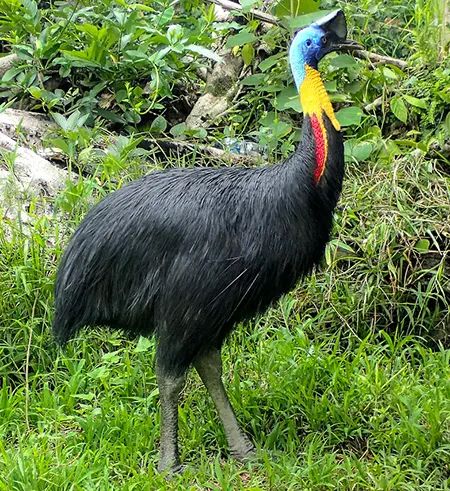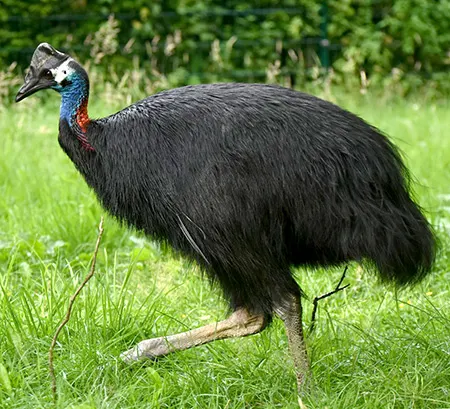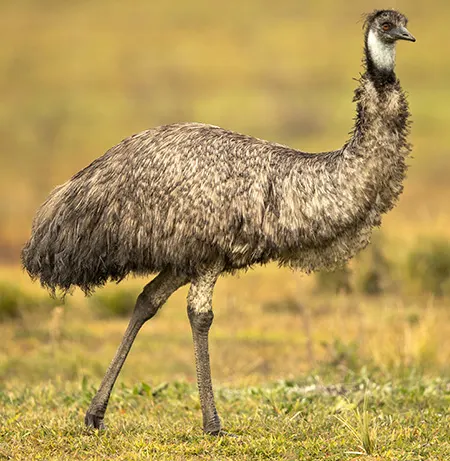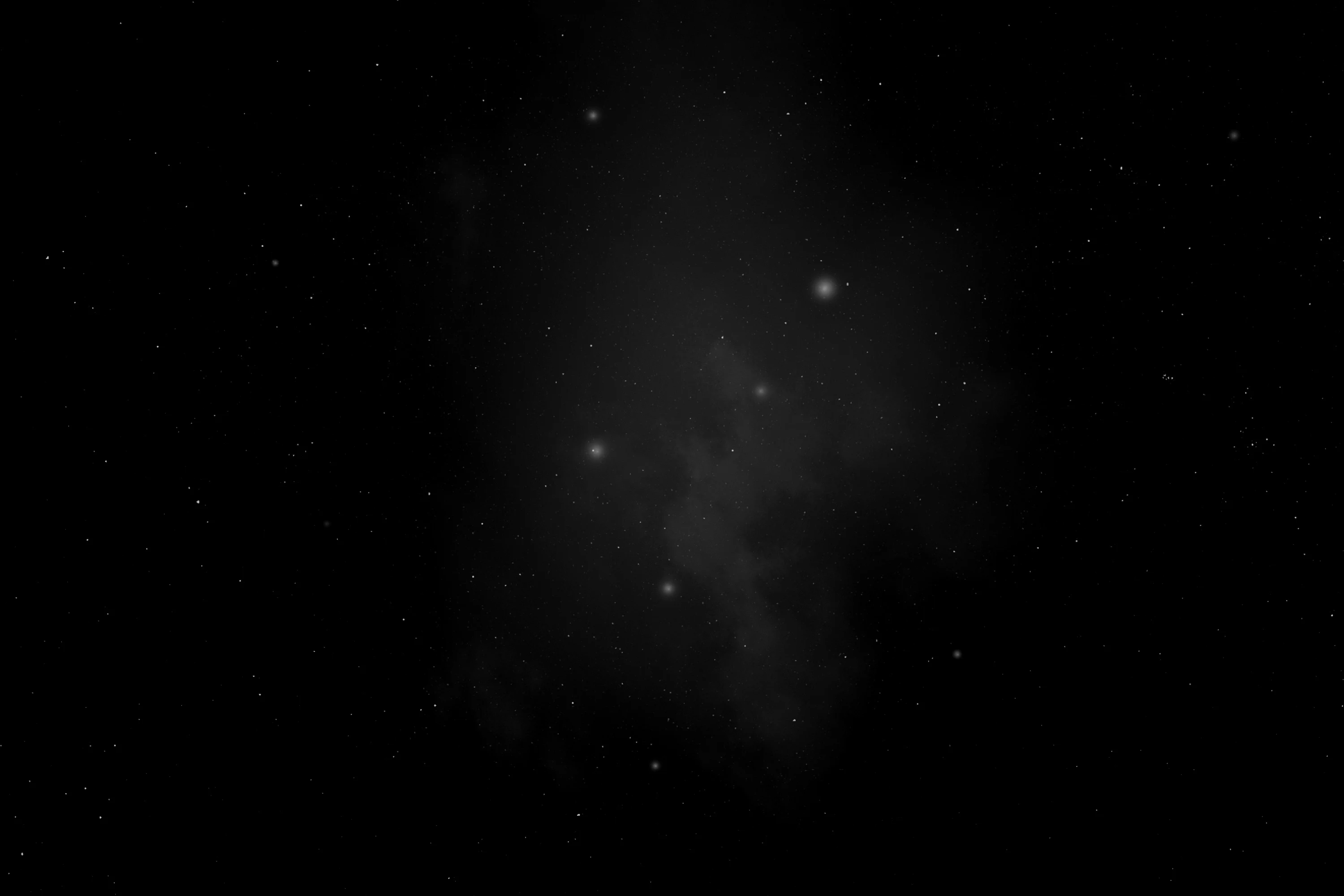
(Casuariiformes)
Cassowaries and Emus
Казуароподібні
The Casuariiformes is an order of large flightless birds that has four surviving members: the three species of cassowary, and the only remaining species of emu. They are divided into either a single family, Casuariidae, or occasionally two, with the emu splitting off into its own family, Dromaiidae. The IOC World Bird List and Cornell Lab of Ornithology’s Birds of the World both do not recognize Dromaiidae, placing the emu in the family Casuariidae.
Reproduction
Throughout its climatically varied range, the emu is a winter breeder; egg laying begins at the end of April. The nest is a flattened bed of bark, grasses, and leaves near a tree or bush and is situated so that the sitting bird (always the male) has a good view of its surroundings. Despite their size, nests are extremely difficult to find. The large green eggs, with granulated shells, average about 130 mm in length and 87 mm in width and weigh 450 to 800 g. They are laid at intervals of about four days, and the male starts to incubate the eggs when the hen has laid five to nine. The normal clutch size is eight, nine, or 10 eggs; large clutches contain up to 16. In exceptionally good seasons as many as 20 eggs may be laid, in poor seasons as few as four or five. Incubation varies from about 58 to 61 days, during which the male seldom leaves the nest, even to feed. The newly hatched chicks, which are concealingly streaked with black, are brooded by the male for two or three days before they begin to move around in his company. Normally two years are required to reach maturity. In the nonbreeding season the groups coalesce into flocks, which may undertake local movements or more extensive migrations. Marking with leg bands has proved that individual emus may travel hundreds of kilometres.
Far less precise data are available on the annual cycle of the cassowaries. According to several observers, the eggs are laid in winter and are incubated by the male for 49 to 52 days. The eggs are paler green than those of the emu and there are fewer in the clutch, which varies from three to eight. Maturity may not be reached until the second or third year. Cassowaries are not gregarious in the nonbreeding season but live as pairs or family parties.
Ecology
Cassowaries are more pugnacious and aggressive than the emu. They are essentially creatures of the tropical rainforests, where they are extremely difficult to observe. Their diet consists mainly of fruit. Emus, on the other hand, live under a wide variety of environmental conditions, ranging from dense temperate forest to open plains and arid scrub country. They frequently exhibit a curious inquisitiveness toward human activities and may be lured to close range by various devices, as for example the waving of objects in the air, a habit that was utilized by the Australian Aborigines in hunting them. Emus are basically vegetarian, subsisting on fruits, seeds, and vegetation of all kinds. They will nevertheless also feed on insects, including caterpillars and grasshoppers, when they occur in great numbers.
Emus and cassowaries swim well and are fast runners. Emus are capable of a stride of nearly 3 m and can keep up with an automobile traveling as fast as 40 to 50 km per hour for some distance.
Vocalizations
Both sexes of the emu are reported to utter resonant drumming notes and guttural grunting calls, under varying conditions. Less is known about the calls of cassowaries, but scattered accounts indicate that they are similar to those of the emu.
Description
Next to the ostrich (Struthio camelus), the emu is the largest and heaviest of living birds; large individuals stand between 1.5 and 1.8 m high and weigh up to 55 kg, although most are well below that weight. Females are slightly larger, averaging about 40 kg, while the males average about 36 kg.
The sexes are alike in colour; the plumage is sombre brown, or brownish black, and the naked skin on the head and neck is blue. All three species of cassowaries are black and, except for the dwarf cassowary, have fleshy pendulous wattles of red, orange, or yellow on the head and neck. The head is crowned with a horny casque, or helmet, believed by some authorities to protect the bird from injury by branches during rapid movements in the forest. The plumage of casuariiforms is loose and hairlike because of the lack of barbules, the secondary branches that interlock to form the flat vane in the feathers of most birds. There are no feathers differentiated as tail feathers, but cassowaries have five quills of the wing modified into hollow, unbranched spines.
As with many running birds, casuariiforms have only three toes, the hind toe having been lost. The inner toe of cassowaries is armed with an elongated, daggerlike claw, making the foot a formidable weapon in kicking.
The casuariiform skeleton is similar to that of the other large flightless birds (ratites) in the reduction of the wing elements and of the keel on the sternum (breastbone) and in the enlargement of the leg elements. Vestigial clavicles (collarbones) remain in the shoulder girdle, but the humerus (upper “arm” bone) is much reduced, being shorter than the combined forewing and manus (“hand”). The manus has a single digit, now believed to be the third, which bears a long claw.
The pattern of bones in the palate, an important diagnostic feature in the taxonomy of ratites, is of the palaeognathous or dromaeognathous type (common to all ratites), in which the vomer bones of the skull extend back to separate the palatines. The casuariiforms have the simplest form of this palate type, with large vomers and short palatines.

(Casuarius casuarius)
Southern Cassowary
Казуар звичайний
It is distributed in Indonesia, Papua New Guinea, and north-eastern Australia. It mainly inhabits tropical rainforests but may make use of nearby savanna forests or mangroves stands. It occurs at elevations of 0–1,200 m.

(Casuarius unappendiculatus)
Northern Cassowary
Казуар жовтошиїй
It is endemic to the coastal swamps and lowland rainforests of the islands of New Guinea, Yapen, Batanta and Salawati, in the countries of Indonesia and the Papua New Guinea. It occurs at elevations of 0–500 m.

(Casuarius bennetti)
Dwarf Cassowary
Казуар малий
It is endemic to the montane cloud forests and tropical rainforests of the islands of New Guinea, New Britain, New Ireland, and Yapen. It occurs at elevations of 30–3,600 m.

(Dromaius novaehollandiae)
Emu
Ему австралійський
It lives in various habitats across Australia, both inland and along the coast. It is most common in areas of savanna woodlands and sclerophyll forests. It occurs at elevations of 0–2,300 m.

